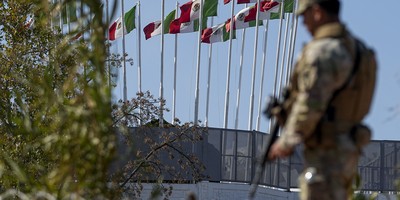One word keeps appearing in reviews of The Hurt Locker , the critically acclaimed war film: realism.
"Realism is the special effect," was the title of one article about the film's producers. "Realism makes for explosive cinema," read the title headline of the Chicago Sun-Times review of the film, which follows a three-member Army Explosives Ordnance Disposal (EOD) team over the last 38 days of its 2004 Baghdad deployment.

Actual EOD technicians have been surprised by the description. So was I, a former Army airborne combat engineer (whose job included blowing things up) and journalist who embedded briefly in 2005 with Navy-Marine EOD near Fallujah. That surprise is because of some of the film's serious unrealities, such as:
The men repeatedly don 100-pound bomb suits (useless if the typical rigged howitzer shell goes off in your face) when remote-controlled robots are routinely used. The primary robot, the Talon , pulls the detonation apparatus apart. If it breaks down, as it did in the opening scene of the film, a smaller backup robot (called a "blowbot") carrying plastic explosives blows apart the wiring. I saw this on my first blast in Iraq.
The three EOD technicians in the film repeatedly fire at the enemy. That rarely happens, though the enemy does shoot at them. Rather, EOD meets up with MPs or other soldiers who handle the combat.
In one tense scene, a Barrett .50-caliber sniper rifle jams because some of the huge rounds have fresh blood on them. No way. The amazingly powerful weapon also would have punched right through the flimsy building material that in the film protects the attackers.
Recommended
It was also irritating to see the soldiers wearing uniforms they wouldn't have been issued until the next year.
In short, The Hurt Locker is not reality but what moviegoers demand: a fast-paced shoot-'em-up. The Sun-Times review title is exactly wrong: Unless the focus is on one extreme, relatively short event – such as Blackhawk Down – reality is financial death for a war film.
That's because reality is the proverbial 99 percent boredom and 1 percent sheer terror. Box-office bucks demand 99 percent action and 1 percent interlude for a bathroom break. Soldiers, too, like those movies – even after seeing the real thing.
The most obvious explanation for what the reviewers perceived as realism is that they know no more about war, Iraq, or EOD than EOD technicians know about reviewing movies.
Fortunately, they are indeed just movie reviewers. Much damage has been inflicted by journalists who "reported" on Iraq from the safety and isolation of their stateside armchairs. Or those who "reported" on combat and the conditions under which combat soldiers must live, and sometimes die, from a Baghdad hotel.
A more complimentary explanation is that the film is visually and emotionally intense, pulling in the audience. When the soldiers are spooked, you're spooked. When they're confused, you're confused.
"Where's the firing coming from?" they ask, desperately scouring the horizon. You find yourself scanning for them. The fog of war drifts from the screen into the theater.
Which is to say I thought it was a damn good movie.
What I was really looking for – besides the action, that is – was respectful treatment of the U.S. soldier in Iraq, as professional a fighter as this nation has ever deployed. And here the term realism truly applied.
The EOD soldiers were scared and often unsure. True, one was a hot dog who repeatedly and needlessly risked his life and those of his teammates. In reality, he probably would have been disciplined, if not replaced. But his actions were central to the plot.
Despite their flaws, these men did their best not just to defuse the bombs and protect U.S. troops, but to protect Iraqi civilians as well.
And there were no hints of glory. That's good. I saw a lot of things in Iraq. Mostly trash heaps, it seems. But I never saw anything glorious.
Granted, the movie soldiers repeatedly faced false dangers. But these nevertheless represented the real ones the movie didn't depict – including being ambushed en route to a mission and hitting bombs planted especially for responding EOD units.
The EOD team that replaced the one I embedded with hit such a bomb in its second week of deployment; two Marines horribly burned to death.
Because the homemade bomb is the insurgents' primary weapon, there's nobody they want to kill more than those who defuse them.
That's the brutal reality. And it's a fitting tribute that the best movie to come out of the Iraq war is a testament to the brave bomb-detonators of the EOD.

























Join the conversation as a VIP Member